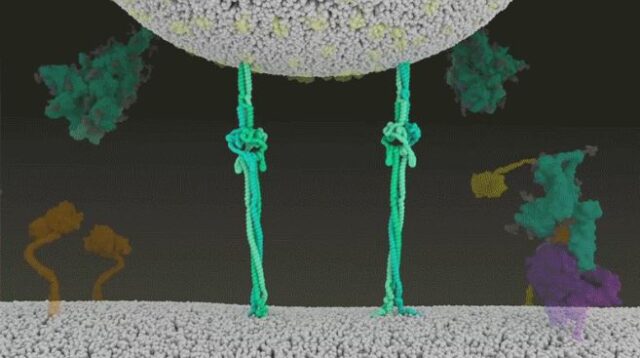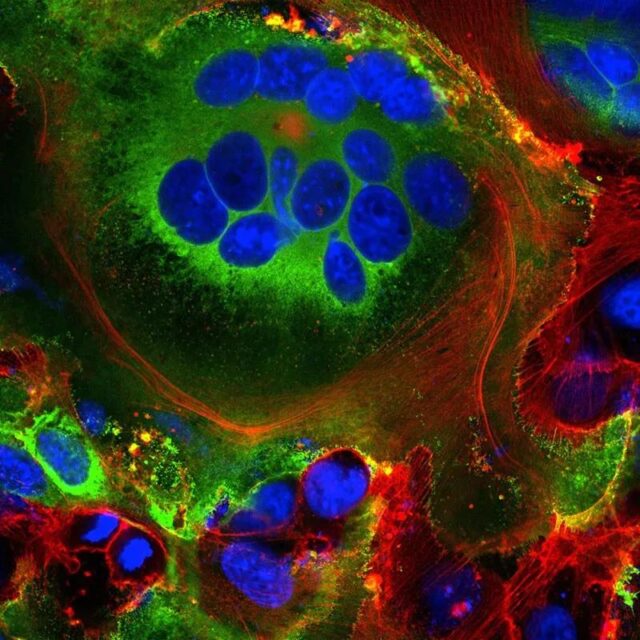Nature: Why is the Delta mutant of COVID-19 so dangerous?
- Why Botulinum Toxin Reigns as One of the Deadliest Poisons?
- FDA Approves Pfizer’s One-Time Gene Therapy for Hemophilia B: $3.5 Million per Dose
- Aspirin: Study Finds Greater Benefits for These Colorectal Cancer Patients
- Cancer Can Occur Without Genetic Mutations?
- Statins Lower Blood Lipids: How Long is a Course?
- Warning: Smartwatch Blood Sugar Measurement Deemed Dangerous
Nature: Why is the Delta mutant of COVID-19 so dangerous?
Nature: Why is the Delta mutant of COVID-19 so dangerous? This article combed the new coronavirus in detail relative to SARS, and explained that the new coronavirus spreads more severely.
The Delta variant strain spreads fast, has a certain immune escape ability, and has a certain possibility to aggravate the disease, so its threat has attracted worldwide attention. Nature’s processes from viruses invading cells, controlling cells, using human cells to enhance their “forces”, and disrupting immune warnings, explains why Delta is so dangerous.
On July 28, local time, Nature posted a blockbuster news feature on the homepage: “How Coronavirus Infects Cells and Why Delta is So Dangerous”. This article sorts out the greater harm of the new coronavirus in the spread of SARS, and analyzes why the mutant strain is so dangerous from the principle of virus structure.

Nature reports articles
Transmission capacity, COVID-19 is stronger and faster than SARS
In the early days of the new coronavirus pandemic, researchers discovered that the receptor binding domain (RBD) of the spike protein of the new coronavirus will bind to the ACE2 receptor on the cell to complete the invasion of the cell. A large number of ACE2 receptors found in human larynx and lung cells are also “stops” for SARS virus invading cells, but compared with SARS, the ability of COVID-19 to bind ACE2 is 2-4 times stronger, which also makes COVID-19 The original strain is more infectious than SARS. The reason for this difference is that the RBD of COVID-19 disease has changed compared with SARS, and it has become easier to combine with ACE2.
Similar to the above principles, several mutant viruses that are causing headaches around the world have also become more transmissible and invasive due to mutations related to RBD. For example, Alpha virus has a transmission power several times that of the original virus. The main reason is that 10 mutations on the spike protein have changed the transmission function of RBDs, making it easier for the virus to invade cells. Delta, which is now popular everywhere, has multiple mutations on the spike protein, among which three mutations on RBD allow it to have stronger ACE2 receptor binding ability and immune escape ability at the same time.
After the spike protein of the new coronavirus is combined with ACE2 on human cells, it does not enter the cell immediately. Next, the virus will inject its own genetic material into the cell through the structure where the two parties “hook up” together. Yes, you read that right. It pulls itself and the cell together through the connected structure, then fuses the cell membrane, and shoots its own genetic material into human cells… Just like the animation below, the upper part is the virus. , Below is the cell, and the green structure in the middle is the enzymatically altered connection structure-it was originally the structure where the spike protein and the ACE2 receptor bind-through this structure, the virus achieves a real invasion of the cell.

The animation is from Janet Iwasa, a virus researcher at the University of Utah, https://animationlab.utah.edu/cova
This transmission structure is also the difference between COVID-19 and SARS. After COVID-19 binds to the ACE2 receptor, it will effectively use TMPRSS2, a biological enzyme that exists widely outside the cells of the respiratory system. This enzyme will efficiently cut the subunits on the spike protein Segment, so that the exposed structure can be quickly inserted into the nearby cell membrane, which is like the lower end of the green rope in the picture above, into the cell membrane of the host. After that, this structure will fold quickly, as shown in the figure above, drawing the virus and the host cell, forcing the two to combine.
In other words, the new coronavirus is using the host’s own biological enzymes to help it invade the host’s cells, and this is just the beginning of its use of the host.
In contrast, SARS virus cannot use such an efficient and “advanced” solution. It must use endosomes as a carrier to enter cells. On the one hand, the use of endosomes is not as fast as the above “zipper” structure. May be trapped by the inner body. This is why chloroquine, which was originally believed to be effective, was eventually found to be ineffective against COVID-19 in clinical trials, because chloroquine affects the coronavirus by interfering with the endosome. Past experience believes that it should be effective, and COVID-19 does not go the same way. Interfering with the SARS intermediary, the endosome, does not affect its direct invasion of cells.
After entering the cell, COVID-19 is mainly against the guest
If you think that COVID-19 combined with our cells is only destroying our cells, then you are wrong-it does a lot more terrible than this.
After the COVID-19 spit out its contents into our cells through the above-mentioned a little disgusting way, it began to use and manipulate human cells to replicate and even arm itself.
First of all, it will violently seize the “regime”-the Nsp1 protein in the first batch of vanguards of COVID-19 entering the cell, will directly “kill” the mRNA without virus markers in the host cell, cutting off our own mRNA working path. Immediately afterwards, the new coronavirus will shut down 70% of the original protein synthesis work in our cells. The Nsp1 protein is still the main force in this process. Its important role is to directly block the ribosome channel by physical methods, so that our own mRNA cannot enter and cannot “support” work (and the inside is not normal because of being cut. jobs).
At this time, the only transcription capacity left in the cell is used to transcribe viral RNA-at this point, the cell has become the site of COVID-19, most of our original protein synthesis work has been stopped, and most of the original employees have been killed. The remaining synthetic materials are used to synthesize the proteins needed by the virus-including fragments such as spike proteins-these fragments use the materials and structures of human cells to complete the assembly to form a new virus, ready to go out to infect new cells.
After entering the cell, COVID-19 will also turn off the cell’s alarm system. This process is achieved through a variety of methods. One of the methods observed by humans is to prevent the mRNA in the nucleus from coming out and to prevent it from producing proteins that can alert the immune system. The same Nsp1 plays an important role. It blocks all the paths in and out of the nucleus, ensuring that nothing can escape. This last method causes many cells to be infected but rarely sends out warning signals. The immune system cannot detect the problem for a period of time. By the time the immune system finds it, the situation may have become very serious, due to the large number of infections. Cells and the immune system will react strongly, which may cause the body to be damaged or even die due to too strong immune response.
Merger cells and expand virus production
After the cell is fully in control, COVID-19 will further transform the cell. The protein fragments it synthesizes in the cell, such as spike protein, may go to the cell surface to change the surface of the cell, allowing the infected cell and the surroundings to express The cells of ACE2 combine to form a huge single respiratory cell with multiple nuclei. The picture below is a fusion cell structure with multiple nuclei formed after being infected by COVID-19. The nucleus is stained in blue, the spike protein is stained in green, and the cytoskeleton is stained in red.

SARS virus cannot form this kind of fusion structure, but in the past it was found that HIV and herpes simplex virus can form this kind of structure. It is hypothesized that this fusion structure can make the infected cells stronger to produce more and more viruses-to put it bluntly, after occupying a cell, COVID-19 merged resources, expanded and upgraded its own The factory occupies more biological resources of human cells and enslaves more human cell labor, so that this factory can manufacture and produce new coronaviruses in larger quantities for a longer period of time.
A Chinese research team has observed that cells infected with COVID-19 can even form such a fusion structure with lymphocytes-lymphocytes are immune cells of the human body, and viruses grab immune cells to form a fusion structure. This behavior is quite bold. We already know that tumor cells use this method to form an immune escape mechanism, but the new coronavirus does not use this method to immune escape-one possible explanation is that the new coronavirus only catches these immune cells patrolling nearby to avoid Being detected is a kind of anti-reconnaissance technology.
In general, the COVID-19 virus’s treatment of human cells is: “inviting guests (spike protein and ACE2 receptors hook together)”, “decapitation (to disable the cell’s own mRNA and most of its own protein production)”, “receive Play as a dog (use human cells to produce more viruses)”.
Will the mutant strain aggravate the disease? Whose condition is aggravated?
Due to the rapid mutation of COVID-19, the speed of research cannot catch up with the new form for the time being-the COVID-19 can automatically mutate in the infected person at a high speed. It is not necessary to be exposed to other coronaviruses. It is just that a large number of mutant strains have not become popular, so we are only observing at present. Some “mainstream” variants have been reached.
Among the mutant strains that are currently receiving more attention, the focus of research is on their enhanced transmission ability. Whether these mutant strains mutate to aggravate the disease has not actually been thoroughly studied. Recently, a Chinese study noted that the Delta mutant strain will grow faster in the lungs and throat of an infected person, and the viral load level will increase thousands of times. However, it is not yet certain whether Delta will aggravate the disease, or whether it will aggravate everyone’s disease.
This high viral load and high growth in the throat and lungs is likely to be related to ACE2 receptors. Previous studies have found that there are ethnic differences in ACE2 receptors. This difference is likely to lead to differences in the ability of the virus to spread between different races and the ability to cause severe illness-such as between East Asians and Caucasians. between.
In other words, the same kind of mutation, due to changes in gene targeting, may lead to more serious consequences in a certain group of people.
At the same time, due to the adaptive mutation of viruses in the human body, hosts with genetic or antibody differences may be screened for more targeted viruses. This kind of risk must be considered in the epidemic prevention strategy.
(source:internet, reference only)
Disclaimer of medicaltrend.org
Important Note: The information provided is for informational purposes only and should not be considered as medical advice.



